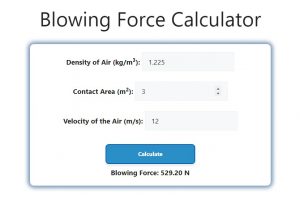About Blowing Force Calculator (Formula)
The Blowing Force Calculator is an essential tool for engineers, designers, and anyone involved in fluid dynamics. This calculator allows users to compute the force exerted by moving air on a surface, which is crucial for applications in various fields such as aerodynamics, HVAC, and wind turbine design. Understanding the dynamics of blowing force helps in optimizing designs and ensuring effective system performance.
Formula
The formula for calculating blowing force is:
Blowing Force = Density of Air * Contact Area * Velocity of the Air².
How to Use
- Collect Required Data: You will need to gather the density of air (in kg/m³), the contact area (in m²), and the velocity of the air (in m/s).
- Input the Values: Enter the values into the calculator for air density, contact area, and air velocity.
- Perform the Calculation: Apply the formula to calculate the blowing force.
- Review Results: Analyze the calculated blowing force to understand its implications for your project or application.
Example
Suppose you want to calculate the blowing force acting on a surface where the air density is 1.225 kg/m³, the contact area is 3 m², and the air velocity is 12 m/s.
Using the formula:
Blowing Force = Density of Air * Contact Area * Velocity of the Air²
Blowing Force = 1.225 * 3 * (12²)
Blowing Force = 1.225 * 3 * 144
Blowing Force = 529.44 N
In this example, the calculated blowing force is approximately 529.44 Newtons.

FAQs
- What is blowing force?
Blowing force is the force exerted by moving air on a surface, influenced by the air’s density, velocity, and contact area. - Why is air density important in this calculation?
Air density affects the mass of air impacting a surface, which directly influences the total blowing force. - How does the velocity of air impact the blowing force?
The blowing force increases with the square of the velocity; therefore, small increases in air speed can lead to significant changes in force. - What units are used for the inputs?
Air density is measured in kg/m³, contact area in m², and air velocity in m/s, while blowing force is expressed in Newtons (N). - Can the calculator be used in different environments?
Yes, you can adjust for varying air densities due to altitude or temperature changes. - What applications benefit from calculating blowing force?
Applications include HVAC system design, wind turbine efficiency assessments, and aerodynamic studies. - How do I measure the density of air?
Air density can be measured using instruments like barometers and thermometers or estimated based on altitude and temperature. - What is the contact area in this context?
The contact area is the surface area over which the air is exerting force, measured in square meters (m²). - Does humidity affect the blowing force calculation?
Yes, humidity impacts air density, which can alter the calculated blowing force. - What happens if the air velocity is zero?
If the air velocity is zero, the blowing force will also be zero, as there is no moving air exerting force. - Can I calculate negative blowing forces?
No, blowing force cannot be negative since it represents a force exerted by air, although negative pressure scenarios may arise. - How can I ensure accurate blowing force calculations?
Ensure precise measurements for air density, contact area, and velocity are used for accurate results. - Is this calculator useful for educational purposes?
Yes, it is an excellent resource for students studying fluid dynamics and forces. - Can blowing force calculations help with safety assessments?
Yes, they are crucial in assessing safety measures in environments with strong air currents. - What are common misconceptions about blowing force?
A common misconception is that blowing force changes linearly with velocity; it actually increases with the square of the velocity. - How does temperature affect air density?
Higher temperatures result in lower air density; thus, it’s essential to account for temperature variations when performing calculations. - Are there limitations to using this calculator?
The calculator assumes ideal conditions; real-world factors like turbulence and flow patterns may affect accuracy. - How does blowing force influence design?
Understanding blowing force is vital for designing efficient systems and ensuring stability and performance. - What is the impact of contact area on blowing force?
A larger contact area results in greater blowing force since more air is acting on the surface. - Can this calculator be used for fan performance testing?
Yes, it can help assess the blowing force generated by fans in different operational conditions.
Conclusion
The Blowing Force Calculator is a valuable tool for professionals and enthusiasts working with air dynamics. By simplifying the calculation of blowing force based on key parameters like air density, contact area, and velocity, this calculator supports effective design and analysis across various applications. Regular use of this tool can enhance system performance, promote better designs, and deepen the understanding of fluid dynamics principles.